Google Nexus 4 Review - Google's new Flagship
by Brian Klug on November 13, 2012 8:45 AM EST- Posted in
- Smartphones
- LG
- Android
- Mobile
- APQ8064
- Nexus 4
- Android 4.2
- MDM9215
Battery life in the Nexus 4 is a big concern for many, especially since the Nexus 4 isn’t designed to have a user replaceable battery. What’s inside is a 2100 mAh 3.8V battery which is 8.0 watt-hours. I had been wondering for a while what the chemical compound used in the 3.8V battery cells we’re seeing emerge was, and finally got a tad more info at least about the LG Chem approach. This is the higher voltage chemistry from LG Chem which is Lithium Cobalt Oxide (LiCoO2) based and includes electrolyte additives to prevent gas generation in the cell which affects lifetime during high temperature periods. Although getting the back off of the Nexus 4 is relatively easy and requires just removing two Torx 4 screws and prying up on the plastic, I doubt anyone is going to make a back to accommodate an extended battery due to the presence of 4 antennas which are integrated into the back cover.
The Nexus 4 incorporates wireless charging into that back alongside NFC. For wireless charging the Nexus 4 uses a TI BQ51051b wireless power Li-Ion charger receiver. I’ve been pretty remiss in looking into wireless charging and actually trying it myself, so I went ahead and bought a two-position Energizer Qi compliant charging mat.
The Nexus 4 is Qi 1.1 wireless charging forum compliant, so any charger that is Qi compliant or includes the logo will charge it. Aligning the Nexus 4 on the Energizer mat is a bit tricky since the surface is slick and angled down, and the back of the Nexus 4 is primarily glass, but it isn’t difficult after you know where to align. The Nexus 4 charges from fully discharged to completely charged in 3.033 hours on the Qi mat, which is basically the same charge time as I saw off of microUSB on a BC 1.2 charger.
In Android you’ll see Charging (Wireless) when this mode is employed. I used the Palm Pre touchstone charger a lot back in the day and saw that get pretty hot during a charge cycle. The Nexus 4 doesn’t get nearly as warm. I’ve noticed that at the top of the charge cycle you’ll see the Nexus 4 selectively draw power from the charging dock since there doesn’t seem to be an equivalent trickle charge mode or something, but this is normal.
Battery Life
I’ve had the chance to run more battery life tests on the Nexus 4, and run the cellular test a few more times. The results are quite consistent and we don’t see that result change very much at all. I’ve also added the call time test and tethering results.
We regularly load web pages at a fixed interval until the battery dies (all displays are calibrated to 200 nits as always). The differences between this test and our previous ones boil down to the amount of network activity and CPU load.
On the network side, we’ve done a lot more to prevent aggressive browser caching of our web pages. Some caching is important otherwise you end up with a baseband test, but it’s clear what we had previously wasn’t working. I’ve made sure that despite the increased network load, the baseband still has the opportunity to enter its idle state during the course of the benchmark, we’re not destroying the RRC states with too aggressive of a load time.
We also increased CPU workload along two vectors: we decreased pause time between web page loads and we shifted to full desktop web pages, some of which are very JS heavy. The end result is a CPU usage profile that mimics constant, heavy usage beyond just web browsing. Everything you do on your smartphone ends up causing CPU usage peaks - opening applications, navigating around the OS and of course using apps themselves. Our 5th generation web browsing battery life test should map well to more types of smartphone usage, not just idle content consumption of data from web pages.
As always we test across multiple air interfaces (3G, 4G LTE, WiFi), but due to the increased network load we actually find that on a given process technology we see an increase in battery life on faster network connections. The why is quite simple to understand: the faster a page is able to fully render, the quicker all components can drive down to their idle power states. All Android tests use Chrome and 5GHz WiFi unless otherwise listed.
The tethering test still consists of four tabs of the webpage tests in conjunction with a 128 kbps streaming MP3 radio station over the smartphone’s personal WiFi hotspot.
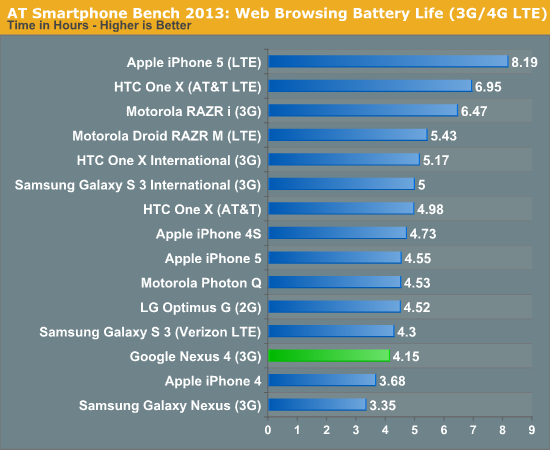
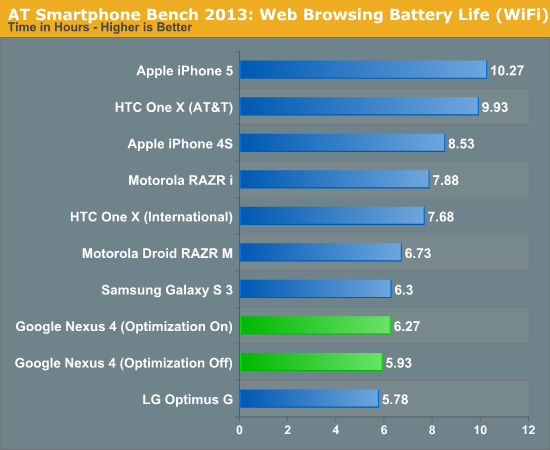
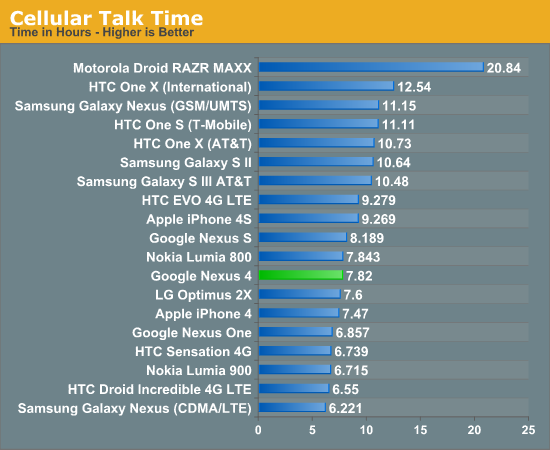
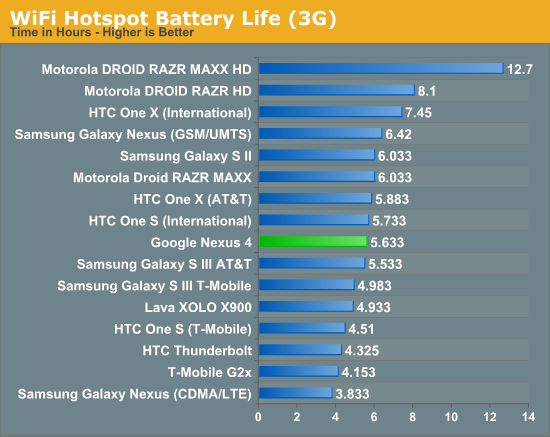
I've run and re-run the battery life tests on the Nexus 4 and they haven't changed since our preview a whole bunch. The result is battery life that isn't really chart topping, yet in my time with the Nexus 4 I haven't really been want for more battery life at any point. I'm able to get through a single day with the device set on auto brightness.



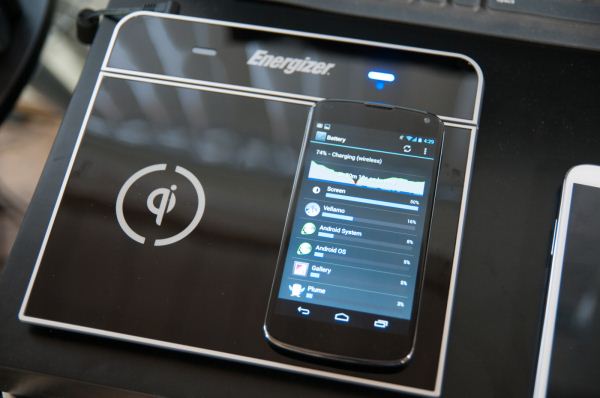

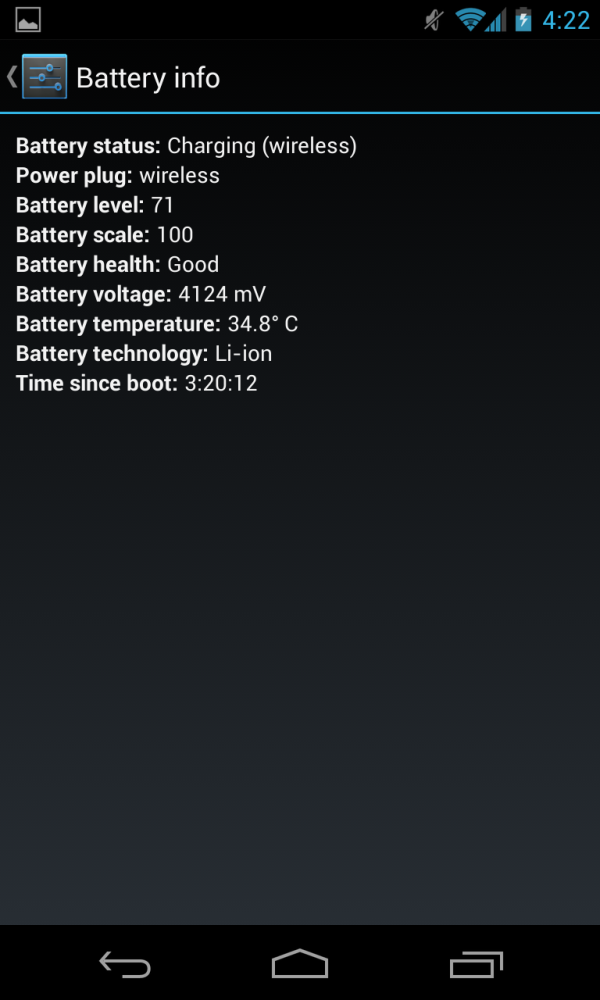








188 Comments
View All Comments
Freedomuser - Wednesday, November 14, 2012 - link
Qualcomm's S4 pro has thermal problems. It will affect daily usage with surrounding temperatures and the battery will be much hotter in higher temperatures.Freedomuser - Wednesday, November 14, 2012 - link
First of, great review. If anyone planning to purchased a device, Anandtech is a stop for a review.I want to know what phones survived your test suit, LG Optimus G fall out. Nexus 4 finished with thermal problems. What about other phones on the charts? Please, list it on the charts.
mrkaupo - Wednesday, November 14, 2012 - link
Great review.Hard to decide Lumia920 or Nexus4.
Nexus hardware and price is great, but L920 design and wp8 is so tempting.
I have to wait for L920 review - camera and battery life is the question for me.
leafspring - Wednesday, November 14, 2012 - link
The performance tests are hilarious. Of what use is a result that has to be achieved by placing the phone in the freezer? I usually don't sit in the freezer when using my smartphone so what are these numbers supposed to tell me?Other than that, nice article. :)
noblemo - Wednesday, November 14, 2012 - link
There are other comments above that address this question. In summary, the freezer tests verify that the initial performance issues were the result of thermal throttling. It is a troubleshooting technique, not a lifestyle recommendation.jian9007 - Wednesday, November 14, 2012 - link
Thanks for the detailed review of the Nexus 4. I always like to come here and read the reviews, as they delve into more intricate areas of products. Keep up the good work.adityanag - Wednesday, November 14, 2012 - link
"Corded up, the Galaxy Nexus can eek out just over 19 Mbps on 64QAM single carrier WCDMA which is the maximum that hardware supports."On the Cellular, Wi-Fi GNSS page, about 3/4ths of the way down the page.
eek is a mouse's cry :)
meloz - Wednesday, November 14, 2012 - link
I had to laugh out loud when I saw the benchmarks with "freezer" results.What a farce. If this is tbe best Google / LG can come up with, Apple truly deserve their pricing premiums and marketshare.
Hopefully Google will be shipping a walk-in freezer with every Nexus 4, so that us users can walk into the freezer to use the full potential of the new wondergadget.
ferrydust - Wednesday, November 14, 2012 - link
Article says: "In fact having the photo table daydream going will slow down charging on that device somewhat dramatically if you’re not careful."I am pleasantly surprised with the Daydream feature, I expect they'll add more settings options for fine-tuning customization, but it's a great start. There is zero interference with charging because all you have to do is press the power button once to turn off the screen! Then no daydream and no powerdrain on that front! But for those times when your're not worried about charging your device but have it docked or sitting someplace and would like to enjoy soothing colors or favorite pictures, the Daydream screensaver feature is a pleasant option.
pmartin - Wednesday, November 14, 2012 - link
If the phone has to placed in the freezer to get all the performance you paid for then the phone is broke. Thanks to this review the phone went from a must buy to a wait till its fixed. Why anyone would buy this phone after reading your review is a retarded fanboy. Thanks for a informative review.